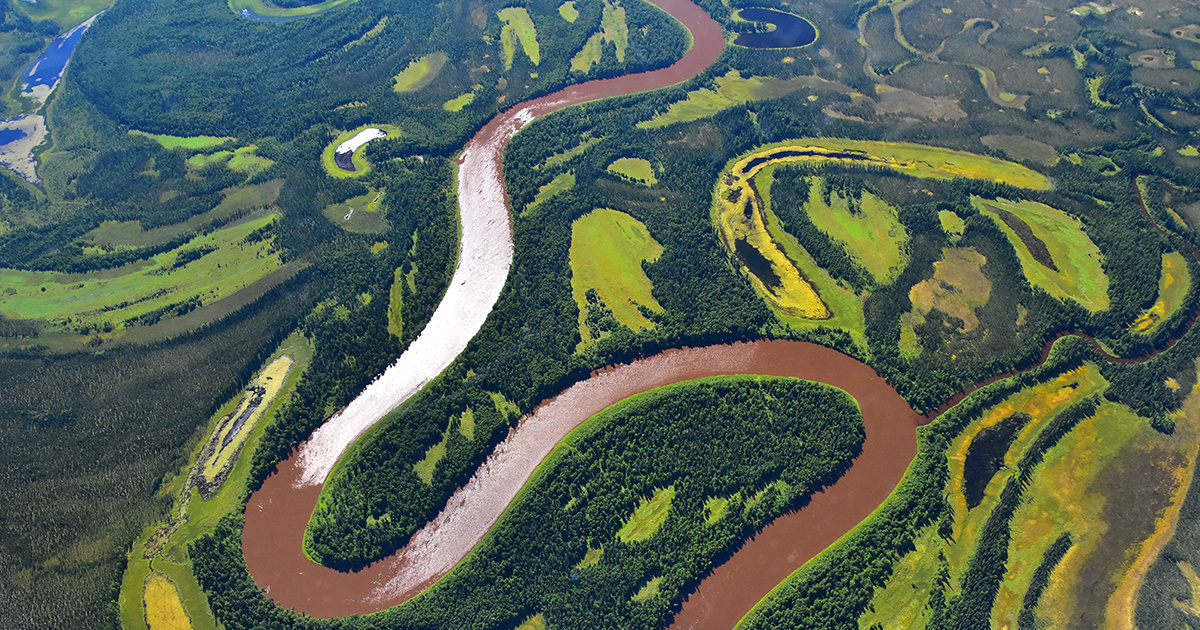

NASA scientists flew over the Kuskokwim river in southwest Alaska in 2017 to investigate how water levels in the Arctic landscape change as permafrost thaws. Peter Griffith, NASA
By Tim Radford
Scientists have identified yet another hazard linked to the thawing permafrost: laughing gas. A series of flights over the North Slope of Alaska has detected unexpected levels of emissions of the greenhouse gas nitrous oxide from the rapidly warming soils.
Nitrous oxide, which chemists know also as laughing gas, is an estimated 300 times more potent as a climate warming agent than the principal greenhouse gas, carbon dioxide. It was present in data recordings at levels at least 12 times higher than all previous estimates.
And it is long-lived: it survives in the atmosphere for around 120 years, according to a separate new study of the microbiology of nitrous oxide. And if it gets even higher, into the stratosphere, it can be converted by the action of oxygen and sunlight into another oxide of nitrogen, to quietly destroy the ozone layer.
Oxides of nitrogen are at least as damaging to stratospheric ozone — an invisible screen that absorbs potentially lethal ultraviolet radiation from the sun — as the man-made chlorofluorocarbons banned by an international protocol three decades ago.
Nitrogen is an inert gas which makes up almost four-fifths of the planet’s atmosphere. It is vital to life: growing plants build their tissues by absorbing carbon dioxide from the atmosphere with the aid of photosynthesis. But they must also absorb nitrogen from plant decay and animal waste, through their roots, with help from soil microbes.
The process is natural, but too slow to help deliver the cereals, tubers and pulses needed to feed seven billion humans and their livestock. For more than 100 years, nations have been making nitrogenous fertilizer in factories and applying it generously to soils to boost harvest yields.
As a consequence, nitrous oxide is now the third most significant greenhouse gas, and the news that it is rising from the permafrost could be troubling.
The permafrost is home to enormous stores of carbon: as soil microbes become warmer and more active, they start to break down long-frozen and partly-decomposed plant material to release both carbon dioxide and potent quantities of methane. The implication is that nitrous oxide could add to the mix, and accelerate warming still further.
Study’s Revelation
“Much smaller increases in nitrous oxide would entail the same kind of climate change that a large plume of CO2 would cause,” said Jordan Wilkerson, a Harvard graduate student who led the research, now published in the journal Atmospheric Chemistry and Physics.
“We don’t know how much more it’s going to increase and we didn’t know it was significant at all until this study came out.”
The research is based on data collected from a series of low-level flights over four different areas of the North Slope of Alaska, and the scientists used a routine technique to determine the balance of gases getting into the atmosphere from what had once been permafrost.
The point of the flights was to measure levels of carbon dioxide, methane and water vapor, but the raw data included information about nitrous oxide as well: information recovered and examined only years later.
Arctic in Change
The weight of the finding is uncertain. One-fourth of the northern hemisphere is home to permafrost — 23 million square kilometers (approximately 8.9 million square miles) — and the flights covered only 310 square kilometers (approximately 120 square miles) in all, and only in the month of August. What could be true for one part of the frozen landscape may not apply to all of it.
And thanks to global warming driven by fossil fuel emissions from the world’s power stations, vehicle exhausts and factory chimneys, the Arctic is changing.
Shrubs and trees are beginning to invade the frozen north. Green things consume nitrogen, and the greening of the Arctic might actually decrease nitrous oxide emissions.
Once again, the study is a reminder of how much more work is needed to understand the chemistry, biology and geophysics of climate change.
Melting Permafrost Emits More Methane Than Scientists Thought https://t.co/7I8LAAMPQf @TheDailyClimate @beyondzeronews
— EcoWatch (@EcoWatch) April 3, 2018
Reposted with permission from our media associate Climate News Network.
- 'We Can't Trust the Permafrost Anymore': Doomsday Vault at Risk in ...
- Antarctic Penguin Poop Emits Laughing Gas - EcoWatch
- Climate Crisis Could Change Permafrost Soil Microbes, With ‘Unknown Consequences’ for Arctic Ecosystems, Scientists Say - EcoWatch

 233k
233k  41k
41k  Subscribe
Subscribe 